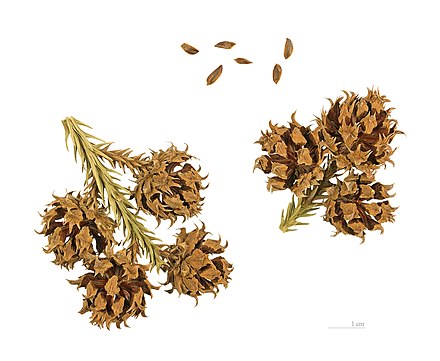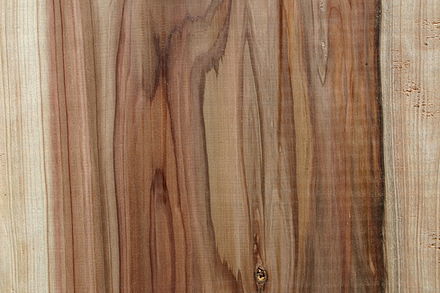Cryptomeria
Cryptomeria (literally "hidden parts") is a monotypic genus of conifer in the cypress family Cupressaceae, formerly belonging to the family Taxodiaceae. It includes only one species, Cryptomeria japonica (syn. Cupressus japonica L.f.). It used to be considered by some to be endemic to Japan (see remark below under 'Endemism'), where it is known as Sugi (杉).[2] The tree is called Japanese cedar[3] or Japanese redwood[4][5] in English. It has been extensively introduced and cultivated for wood production on the Azores.
Cryptomeria is a very large evergreen tree, reaching up to 70 m (230 ft) tall and 4 m (13 ft) trunk diameter, with red-brown bark which peels in vertical strips. The leaves are arranged spirally, needle-like, 0.5–1 cm (1⁄4–3⁄8 in) long; and the seed cones globular, 1–2 cm (1⁄2–3⁄4 in) diameter with about 20–40 scales. It is superficially similar to the related giant sequoia (Sequoiadendron giganteum), from which it can be differentiated by the longer leaves (under 0.5 cm or 1⁄4 in in the giant sequoia) and smaller cones (4–6 cm or 1+1⁄2–2+1⁄4 in in the giant sequoia), and the harder bark on the trunk (thick, soft and spongy in giant sequoia).
Sugi has been cultivated in China for so long that it is frequently thought to be native there. Forms selected for ornament and timber production long ago in China have been described as a distinct variety Cryptomeria japonica var. sinensis (or even a distinct species, Cryptomeria fortunei), but they do not differ from the full range of variation found in the wild in Japan, and there is no definite evidence the species ever occurred wild in China. Genetic analysis of the most famous Chinese population, on Tianmu Mountain, containing trees estimated to be nearly 1000 years old, supports the hypothesis that the population originates from an introduction.[6]
Outside of its native range, Cryptomeria was also introduced to the Azores in the mid 19th century for wood production. It is currently the most cultivated species in the archipelago, occupying over 12,698 hectares, 60% of the production forest and about 1/5 of the region's total land area.[7][8]
Cryptomeria grows in forests on deep, well-drained soils subject to warm, moist conditions, and it is fast-growing under these conditions. It is intolerant of poor soils and cold, drier climates.[9]
It is used as a food plant by the larvae of some moths of the genus Endoclita including E. auratus, E. punctimargo and E. undulifer. Sugi (and hinoki) pollen is a major cause of hay fever in Japan.


